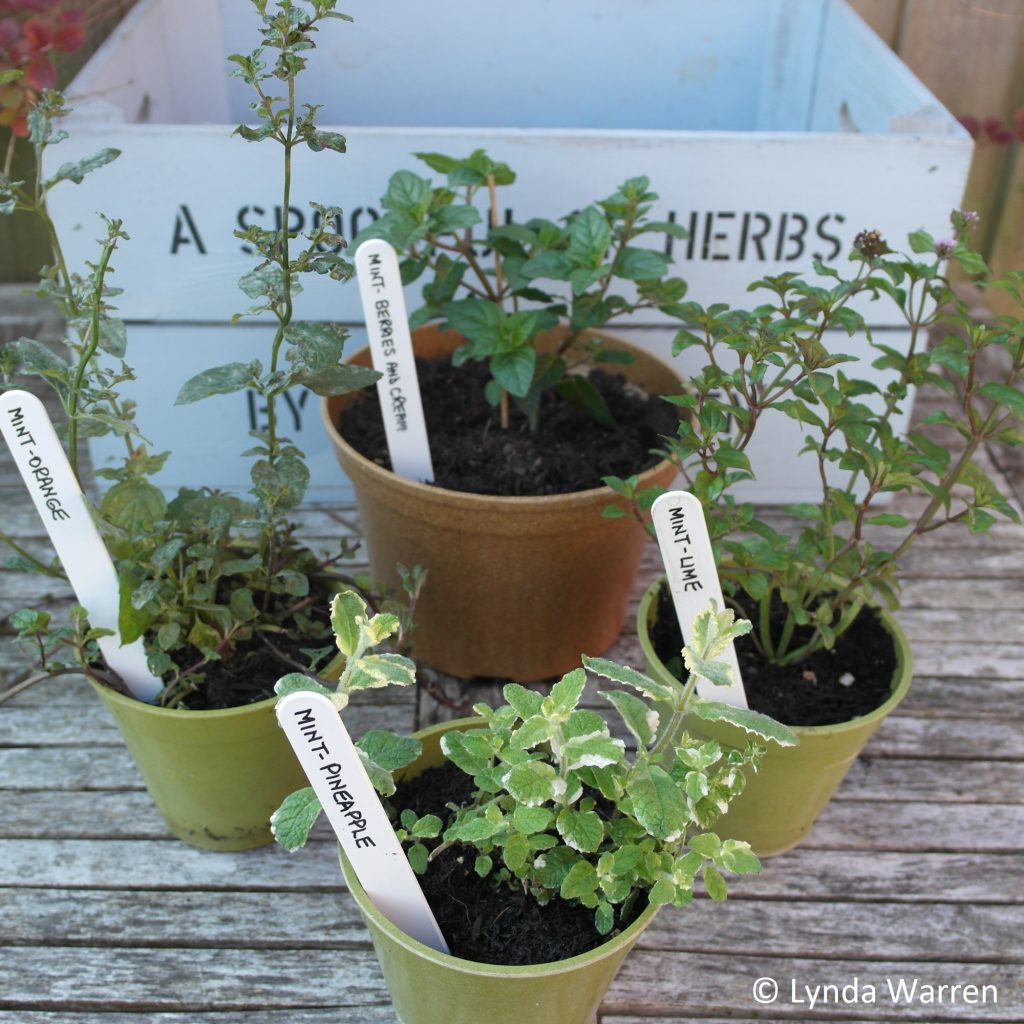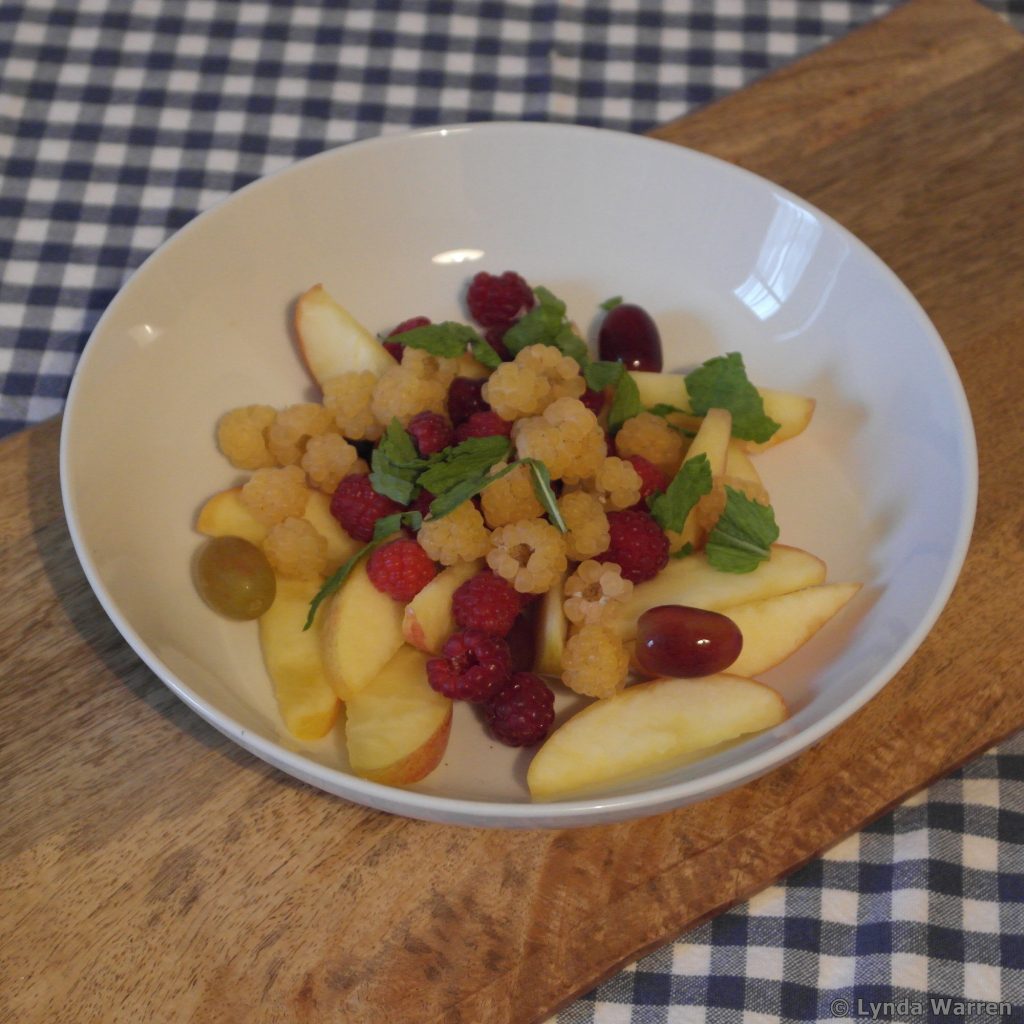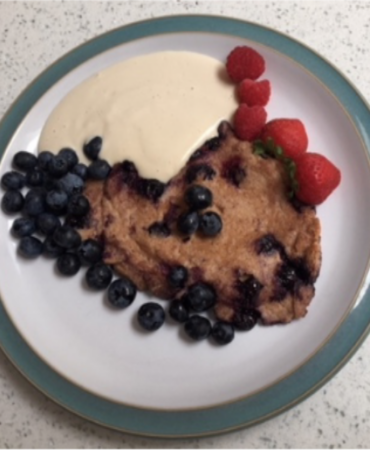Currently Empty: £0.00

MARVELLOUS MINT PART 3 – Cooking with herbs
If you are a Herb Society member and wish to write for the blog, get in touch with your ideas at blog@herbsociety.org.uk
Written for the UK Herb Society by Lynda Warren, Herb Society Ambassador and Public Speaker www.aspoonfulofherbs.co.uk
The photos used in this post belong to Lynda Warren and should not be replicated. All images © 2022
Please note: Fresh and dried herbs Even though fresh and dried herbs are a natural product; they contain chemical substances that may sometimes have marked side-effects. Herbs may, on rare occasions, also cause allergic reactions and interact with prescription and over the counter medicines. If in any doubt, please consult a doctor.
COOKING WITH HERBS
The following information should apply to most herbs that you have in your garden.
If you are planning on cooking with a lot of herbs, you may wish to collect a few of the following items, or add them to your birthday and Christmas wish list:
- Herb keeper, keeps herbs fresh for up to two weeks with this smart system designed to fit right inside your refrigerator door, there’s a plastic reservoir at the base of the container for water
- Herb snips for cutting herbs from your fresh plants
- Herb scissors and brush, a quick way of chopping herbs, the brush is essential as the five blades are very sharp
- Mezzaluna, traditional knife with a curved blade with a handle on each end that is rocked back and forth to chop herbs
- Herb/spice mill or rotary cutter, although I don’t get on well with these with fresh plants and tend to use them on bunches of dried herbs
- Herb strainer or culinary muslin and string, these contain the herbs and prevent you having to fish around to get them out of the finished dish (make sure both the muslin and string are free from chemicals by using those labelled culinary)
- Pestle and mortar, used since the Stone Ages to prepare ingredients by crushing and grinding them into a fine paste or powder, the mortar is the bowl, the pestle a club shaped object, they are usually made from hard wood, metal, ceramic, or granite
In addition to your general kitchen equipment, it would also be useful to have:
| Chopping boards | Plastic wrap |
| Double boiler and saucepans | Saucepans and baking dishes |
| Food scale in ounces and grams | Silicon spatula |
| Funnel | Storage containers: Glass Kilner or Mason jars, glass bottles |
| Garlic press | Strainer, from tea size upwards |
| Glass and plastic mixing bowls | Vegetable peeler |
| Knives and sharpening steel | Wire whisk |
| Measuring cup/jug for liquids | Wooden spoons and spatulas |
| Microplane zester (a fine grater for lemons etc) | Possibly a food liquidiser or processer, and a notebook to record all your herbal discoveries! |
| Parchment paper |
Cooking with fresh herbs
Preparing your fresh herbs
Only wash them if you’re going to use them immediately, otherwise store them in your fridge unwashed. To best way to do this is fill a bowl with cold water and place your herbs inside. Gently move them around the water to remove any dirt. If there is a significant amount of sediment at the bottom of the bowl, pour away the water and give the herbs another rinse. Gently pat them dry using a paper towel or give them a whirl in a salad spinner.
Chopping fresh herbs
A sharp knife is a must and makes preparing food a safer, quicker, and more enjoyable experience. Whether you’re throwing your herbs into a food processor or chopping them by hand, ensure that the blade you are using is sharp. A dull blade may bruise your herbs, changing the colour of your leaves from a vibrant green to a dull black. Ordinary kitchen scissors can also be used if you’re not concerned about achieving small, uniform pieces.
To maximize the flavour of your herbs you’ll want to chop them as finely as possible. This is because the finer you chop your herbs the more oils are released and the more fragrant the herb will become. Delicate herbs like basil and coriander should be chopped just before use as they will lose their aroma quickly. It’s often recommended to add these more delicate herbs after you’ve taken your dish off the heat or right before serving.
Master the chiffonade! I am sure you’ve seen those skinny strips of basil and other herbs that show up on restaurant salads and soups, but do you know how to make them at home? It’s easier than you might expect. Simply roll a few leaves up into a cylinder and slice them across the roll to create ribbons. Or use the herb scissors mentioned earlier.
When to add fresh herbs
This depends not only on the herb but also on the depth of flavour you’re trying to achieve. Robust herbs like bay, mint, rosemary, savory, and thyme can be used in longer simmering dishes. But be careful not to overdo it on the mint as it has quite a strong flavour. Gently bruise the leaves with your fingers before dropping them in to release more oils and increase flavour.
Adding herbs at the beginning of your cooking will create a subtle background note. If at the end you find you want to punch up the flavour, just add a bit more for
reinforcement. Remember, you don’t want any one flavour to stand out too much. If you keep the leaves on their stems, they will be easier to remove later. Using a bouquet garni is another option that will keep you from losing your herbs in a sauce, soup, or casserole. This also allows you to control the flavour if you find the herbs are becoming overpowering. Taste and either remove or leave in, depending on your
requirements.
Another way to use your herbs is a bouquet garni. The term means a garnish bouquet and was recorded as far back at 1600 in France, appearing in the book ‘Le Cuisinier François’ written by François Pierre de la Varenne in 1651, although it did not make an appearance in English cookery until the 19th Century.
The usual herbs are bay, parsley and thyme, there is no standard combination and depending on the recipe it may also include basil, salad burnet, chervil, rosemary, savory, and tarragon. Sometimes vegetables such as carrot, celery and leek are also included. In Provence, a slice of dried orange is often added.
Cooking with dried herbs
Using dried herbs in your cooking will give you very similar results to using fresh herbs if you are careful to pay attention to how much you are adding. Dried herbs are more flavourful than fresh, so you need to use one half of the quantity of dried herbs that the recipe calls for in fresh. So, if it requires a tablespoon of fresh rosemary, use half a tablespoon of dried rosemary and vice versa. Add more as needed, or until you’ve reached the level of herby flavour you prefer.
One of the easiest ways to add dried herbs to avoid getting any hard pieces left in your meal is to put them in a herb strainer and remove it before serving.
Should I rehydrate my dried herbs?
It depends on what you are going to be using the dried herbs for. Since dried herbs are just herbs with the water removed, in general they tend to work better in dishes where they must be incorporated into the recipe instead of being rehydrated beforehand.
Herbs with a strong flavour such as thyme, rosemary, mint, parsley, and oregano can be added at the beginning of cooking a dish, as they will take some time for the flavours to fully develop.
Lighter, more delicate herbs such as basil and marjoram should be added closer to the end of cooking. Their sweet, light flavours may turn sour if cooked for too long or end up burning. Worse still, they may lose all their flavour entirely.
There are even a few herbs, including marjoram and oregano that work better in dishes if they are dried, as opposed to fresh, because their essential oils are released more readily in their dried form than when fresh. However, when cooking in a slow cook pot, add your herbs toward the end! No herb will survive an 8-hour low and slow cook in a crock pot without losing all its flavour.
How do I store dried herbs and how long do they last?
Dried spices and herbs last surprisingly long if kept in the correct conditions. They should be completely dry to start with and need an airtight container, preferably
glass. A cool, dark environment is ideal, so try to make your storage cabinet one that is as far away as possible from your cooker top, oven, or even the dishwasher. Also, try not to avoid sprinkling herbs directly from their container into a steaming pot, this can make a perfect jar of herbs become damp and spoiled.
Dried ground herbs like basil, parsley, and oregano last for 2-3 years. If they are dried and stored in their natural, whole form (such as bay leaves), then they should last a little longer, around 3-4 years. Many people have a few packets of old herbs lurking at the back of their cupboard. Most have an expiry date on them, particularly more recent ones, so it’s well worth checking out just how old they are.
You should also smell and look at your herbs. If they have no scent or colour, they probably won’t add anything to your dish. Just place a small amount of the spice in your palm, rubbing vigorously, and taking a sniff. Your rubbing will activate the oils and it should smell strong. If the rubbed spice smells faint, you should replace it. Although you can try doubling the quantity.
At my talks I have spoken to people who are concerned their dried herbs are losing their flavour, only to find out they have been in the cupboard for too many years. Fresh herbs are nice to use when they are available, but don’t underestimate the flavours of those dried herbs, especially in dishes that take a while to cook.
COOKING WITH MINT
Fresh or dried, mint tastes sweet and produces a lingering cooling effect on the tongue. Peppermint has a stronger flavour with more menthol taste. Perfect when added to new potatoes, peas, fruit salad and summer drinks, or added to vinegar and sauces. Traditionally used with lamb. Add at the beginning or end of cooking. One of the most common mints to use is Mentha spicata (garden or spearmint). Perfect for mint tea.

For flavour, mint is best used fresh, a sprig or two is traditionally used in pots of boiling potatoes, and chopped fresh mint is good with cucumber in a raita. Add several sprigs of mint to peas, green beans or new potatoes whilst boiling.
A traditional mint sauce, to serve with lamb, is a green sauce made from finely chopped peppermint leaves soaked in vinegar, and a small amount of sugar, sometimes with the addition of lime juice. Alternatively, you can make a mint jelly to go with your roast meat.
Add fresh mint to cold soups or hot tomato and bacon soups. Use to make curries or to marinade for lamb. Add chopped mint to rice, chickpea, couscous, or bean dishes. It is used in Greek mint balls and classic Middle Eastern dishes.
You can also use mint to flavour cakes, meringues, and biscuits. Add to a homemade or pre-prepared chocolate sauce for a choc and mint sauce, or coat with melted chocolate for a tasty, topping for fruit salads and ice cream. Use as it just as it is for a garnish for iced drinks, including cocktails, and fruit desserts.

Here are a few of my favourite herb recipes.
My version of tabbouleh – a substantial Middle Eastern salad
Serves four.
- 1 cup couscous
- 2 cups vegetable broth
- 2 cups chopped parsley
- 6 chopped spring onions
- 1 cup sliced cherry tomatoes
- 1 cup diced cucumber
- ¼ cup chopped fresh mint
- ½ cup lemon juice
- Zest from the lemons
- ½ cup olive oil
- Sea salt and black pepper
- (Traditional tabbouleh also includes fennel, however as I am not a fan of its aniseed
flavour, I have left it out.) - Cook couscous according to instructions, using the vegetable broth.
- When cool, combine everything together and mix well.
Chill until needed and use within a couple of hours
Alternative ingredients for a gluten free Tabbouleh: 1 cup quinoa cooked as per
instructions on packet, 3 bunches fresh flat leaf parsley and 1 bunch mint chopped, 3 spring onions sliced, 3 ripe tomatoes deseeded and diced, 1 cucumber cut into cubes, juice of one lemon, extra virgin olive oil and salt and pepper.
Easy mint dressing
- ½ cup herbs mint
- 2 small garlic cloves minced
- 2 spring onions
- Zest of 1 lemon plus 1 tablespoon lemon juice
- ½ each of teaspoon salt, ground black pepper and red chilli flakes
- 6 tablespoon olive oil
- Finely chop herbs and spring onions.
- Stir together with other dressing ingredients except oil.
- Now slowly whisk in oil. Or simply put all the ingredients in a processor and pulse to blend well. Taste and adjust seasonings to your liking.
The herb saue will keep in the fridge in a sealed container for about a week. The vibrant green colour will fade a bit though. The colour may stay greener using lemon zest only without adding lemon juice.
Minty salsa
- 1 medium green chilli deseeded and finely chopped
- 400 g can chopped tomatoes
- 1 bunch spring onions chopped thinly
- Handful of fresh garden mint leaves chopped
- Juice of half a lemon
- Sea salt and black pepper to taste
- Put all the ingredients in a large bowl, mix well and season to taste.
- Garnish with a few whole mint leaves.
- Refrigerate until needed.
Serve at room temperature with lamb burgers, kebabs, or roast lamb, and buttered new potatoes.
Yoghurt salad dressing
- 150ml 0% fat yoghurt
- Handful of mint and coriander, finely chopped
- Juice of half a lemon
- Sea salt and black pepper
- Simply mix all the ingredients together and store in the refrigerator until needed.
If you have more ideas for cooking with mint, let us know.
Mint 4 next month will explore using mint in health and beauty.
Written by Lynda Warren UK Herb Society Ambassador and Public Speaker. Find out more or get in touch via our Ambassador’s page here.




